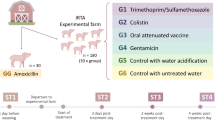Abstract
The prevalence, distributions and antibiotic resistance pattern among enterococci species were determined. A total of 30 samples of Nigerian traditional fermented dairy food were positive to presence of enterococci, with viable counts of 4.17 log CFU/g in nunu, lower than 4.55 log CFU/g observed in wara samples. Twenty-five representative strains were characterized by a combination of phenotypic and genomic typing based on 16S rRNA gene and multi-locus sequencing analysis (MLSA) of RNA polymerase A (rpoA) and phenylanaline synthase (pheS) genes sequencing; these strains were identified as Enterococcus faecium (84 %) and Enterococcus faecalis (16 %). All the 95 enterococci isolated from wara and nunu samples were alpha haemolytic with multi-drug resistance to 10 antimicrobials regardless of class. Four strains were sensitive to chloramphenicol (30 μg) while 33.7 % of the total isolates were resistant to vancomycin from 5 μg. This information will enhance understanding of Enterococcus drug resistance and distribution in traditional fermented foods to support safety and guarantee quality of traditional foods in West Africa.


Similar content being viewed by others
References
Adeyemi IA, Umar S (1994) Effect of method of manufacture on quality characteristics of kunun-zaki, a millet-based beverage. Niger Food J 12:34–41
Carina AM, Torres MJ, Sabate DC, Ibarguren C, Apella MC (2011) Properties of different lactic acid bacteria isolated from Apis mellifera L. bee-gut. Microbiol Res 166:1–13
Colombo E, Franzetti L, Frusca M, Scarpellini M (2010) Phenotypic and genotypic characterization of lactic acid bacteria isolated from Artisanal Italian goat cheese. J Food Prot 73:657–662
De Vuyst L, Foulquie Moreno MR, Revets H (2003) Screening for enterocins and detection of hemolysin and vancomycin resistance in enterococci of different origins. Int J Food Microbiol 84:299–318
Eka OU, Ohaba JA (1977) Microbiological examination of Fulani milk (nono) and butter (manshanu). Niger J Sci 11:113–122
Franz CM, Specht I, Haberer P, Holzapfel WH (2001a) Bile salt hydrolase activity of enterococci isolated from food: screening and quantitative determination. J Food Prot 64:725–729
Franz CM, Muscholl-Silberhorn AB, Yousif NM, Vancanneyt M, Swings J, Holzapfel WH (2001b) Incidence of virulence factors and antibiotic resistance among enterococci isolated from food. Appl Environ Microbiol 67:4385–4389
Gardiner GE, Ross RP, Wallace JM, Scanlan FP, Jagers PP, Fitzgerald GF, Collins JK, Stanton C (1999) Influence of a probiotic adjunct culture of Enterococcus faecium on the quality of cheddar cheese. J Agric Food Chem 47:4907–4916
Han D, Unno T, Jang J, Lim K, Lee SN, Ko G, Sadowsky MJ, Hur HG (2011) The occurrence of virulence traits among high-level aminoglycosides resistant Enterococcus isolates obtained from feces of humans, animals, and birds in South Korea. Int J Food Microbiol 144:387–392
Jackson CR, Lombard JE, Dargatz DA, Fedorka-Cray PJ (2011) Prevalence, species distribution and antimicrobial resistance of enterococci isolated from US dairy cattle. Lett Appl Microbiol 52:41–48
Kuhn I, Iversen A, Burman LG, Olsson-Liljequist B, Franklin A, Finn M, Aarestrup F, Seyfarth AM, Blanch AR, Vilanova X, Taylor H, Caplin J, Moreno MA, Dominguez L, Herrero IA, Mollby R (2003) Comparison of enterococcal populations in animals, humans, and the environment–a European study. Int J Food Microbiol 88:133–145
Lane DJ, Pace B, Olsen GJ, Stahl DA, Sogin ML, Pace NR (1985) Rapid determination of 16S ribosomal RNA sequences for phylogenetic analysis. Proc Natl Acad Sci USA 82:6955−6959
Lenz CA, Hew Ferstl CM, Vogel RF (2010) Sub-lethal stress effects on virulence gene expression in Enterococcus faecalis. Food Microbiol 27:317–326
Lopez M, Saenz Y, Alvarez-Martinez MJ, Marco F, Robredo B, Rojo-Bezares B, Ruiz-Larrea F, Zarazaga M, Torres C (2010) Tn1546 structures and multilocus sequence typing of vanA-containing enterococci of animal, human and food origin. J Antimicrob Chemother 65:1570–1575
Naser SM, Thompson FL, Hoste B, Gevers D, Dawyndt P, Vancanneyt M, Swings J (2005) Application of multilocus sequence analysis (MLSA) for rapid identification of Enterococcus species based on rpoA and pheS genes. Microbiology 151:2141–2150
Naser SM, Dawyndt P, Hoste B, Gevers D, Vandemeulebroecke K, Cleenwerck I, Vancanneyt M, Swings J (2007) Identification of lactobacilli by pheS and rpoA gene sequence analyses. Int J Syst Evol Microbiol 57:2777–2789
Oguntoyinbo FA, Sanni AI, Franz CMAP, Holzapfel WH (2007) In vitro selection and evaluation of Bacillus starter cultures for the production of okpehe, a traditional African fermented condiment. Int J Food Microbiol 113:208–218
Olasupo NA, Schillinger U, Franz CMAP, Holzapfel WH (1994) Bacteriocin production by Enterococcus faecium NA01 from “wara” a fermented skimmed cow milk product from West Africa. Lett Appl Microbiol 19:438–441
Sangoyomi TE, Owoseni AA, Okerokun O (2010) Prevalence of enteropathogenic and lactic acid bacteria species in wara: a local cheese from Nigeria. Afr J Microbiol Res 4(15):1624–1630
Scheidegger EMD, Fracalanzza SAP,Teixeira LM, Cardarelli-Leite P (2009) RFLP analysis of a PCR-amplified fragment of the 16S rRNA gene as a tool to identify Enterococcus strains. MemInst Oswaldo Cruz 104:1003–1008
Semedo T, Santos MA, Lopes MF, Figueiredo Marques JJ, Barreto Crespo MT, Tenreiro R (2003) Virulence factors in food, clinical and reference enterococci: a common trait in the genus? Syst Appl Microbiol 26:13–22
Tansuphasiri U, Khaminthakul D, Pandii W (2006) Antibiotic resistance of enterococciisolated from frozen foods and environmental water. Southeast Asian JTrop Med Public Health 37:162–170
Uzeh RE, Ohenhen RE, Rojugbokan AK (2006) Microbiological and nutritional qualities of dairy products nono and wara. Nat Sci 4:37–40
Yousif NM, Dawyndt P, Abriouel H, Wijaya A, Schillinger U, Vancanneyt M, Swings J, Dirar HA, Holzapfel WH, Franz CMAP (2005) Molecular characterization, technological properties and safety aspects of enterococci from 'Hussuwa', an African fermented sorghum product. J Appl Microbiol 98:216–228
Author information
Authors and Affiliations
Corresponding author
Rights and permissions
About this article
Cite this article
Oguntoyinbo, F.A., Okueso, O. Prevalence, distribution and antibiotic resistance pattern among enterococci species in two traditional fermented dairy foods. Ann Microbiol 63, 755–761 (2013). https://doi.org/10.1007/s13213-012-0530-8
Received:
Accepted:
Published:
Issue Date:
DOI: https://doi.org/10.1007/s13213-012-0530-8




